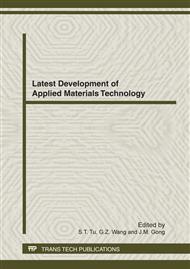p.114
p.121
p.125
p.132
p.135
p.138
p.147
p.150
p.152
Power Modulated Plasma-Polymerized Gradient Anti-Fingerprint Transparent Protective Coating with a Gradient Composition
Abstract:
Polymeric materials have been widely used as flexible substrates and housing parts of modern electronic wares. However, their low hardness and scratch resistance must be improved by additional protective surface coatings, which require not only mechanical durability but also additional functions such as surface hydrophobicity, oleophobicity as well as anti-fingerprint performance. To satisfy these, a power modulated plasma polymerization technique was designed to synthesize a transparent compositional gradient coating on polycarbonate (PC) substrate. Firstly, a constant flow rate of tetramethyldisiloxane (TMDSO) precursor was introduced where higher plasma power was employed to deposit a hard H-C-Si-O bottom layer. The plasma power was then decreased meanwhile admitting increased fluoromethane (CF4) gas flow as the second precursor to obtain a top layer with low surface energy. The hard bottom layer acts as a strong mechanical support and the top layer gives additional hydrophobicity and oleophobicity. Ultimately, the coating shows that a pencil hardness of 3H and Scotch-tape adhesion of 5B improves its protective function. A water contact angle of 105° and oil contact angle of 31.7° can be obtained. The coated specimen remains an optical transparency of 90% close to bare PC material. Comparing with commercialized screen protectors, the developed coating shows superior protective and anti-fingerprint performance.
Info:
Periodical:
Pages:
135-137
Citation:
Online since:
April 2012
Authors:
Price:
Сopyright:
© 2012 Trans Tech Publications Ltd. All Rights Reserved
Share:
Citation:


